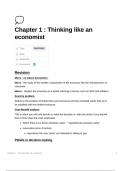Summary
Summary Microeconomics and Behaviour: South African Edition - Economics 214 (Ecos214)
- Course
- Institution
- Book
These notes are compiled from the text book. It consists of chapter 1,2,3,4,7,8,9,10,11. They are made from the textbook, class nites and lecture slides. Great quality and neat presentation. Includes graphs and explanations.
[Show more]










